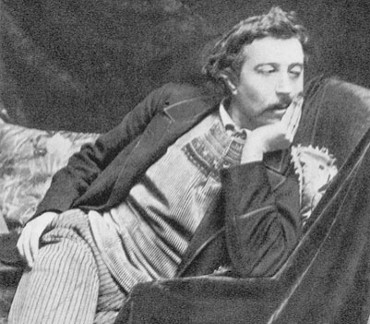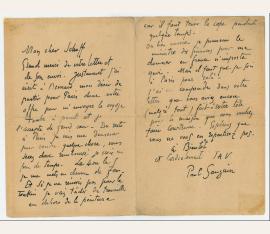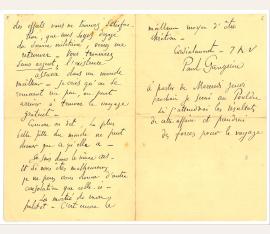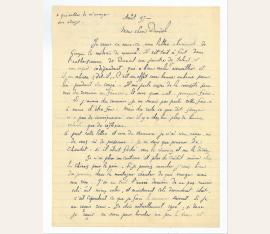French painter (1848-1903). Autograph letter signed. N. p. o. d. 8vo. 2 pp. on bifolium.
$ 31,959 / 30.000 €
(49665/BN34076)
To Émile Schuffenecker, thanking him for arranging for Gauguin to travel to Paris by train: „Thank you very much for your letter and for sending it. I just wrote Bernard about my desire to leave for Paris; thus, your offer to send me on the trip comes just at the right time and I happily accept it. Moreover, I will organize to sell something in Paris, and therefore you will be reimbursed within short time, I believe. On the 4 or the 5 I will take the train. And if I dont make it to Tonkin I will try to work outside of painting for some time because it’s necessary to hold course.
Or I will rather push the minister of finance to give me something in France. But I would have to be in Paris for that. [...]“. - The French Post-Impressionist artist, painter, art teacher and art collector Émile Schuffenecker (1851-1934) was a close friend of Paul Gauguin and Odilon Redon, and one of the first collectors of works by Vincent van Gogh. Until the early 1890s when Gauguin and Schuffenecker quarrelled, Schuffenecker gave great support to Gauguin, encouraging him to take up a career as a painter. He also had the idea for the 1889 Exhibition at the Volpini Gallery, a key moment in Gauguin's influence on young painters..
French painter (1848-1903). Autograph letter signed ("Paul Gauguin"). [Paris. Small 8vo. 6 pp. on bifolia.
$ 37,286 / 35.000 €
(80966/BN52912)
Important letter in French to the painter Émile Bernard (1868-1941) announcing his plan to move to Madagascar so as to found a "workshop of the tropics" where fellow artists could join him: "Irrevocably I will go to Madagascar - I will buy a clay house in the country that I will enlarge myself, grow plants and lead a simple life [...] Then I will found the workshop of the tropics - whoever wishes can come there to meet me." Always short of money, Gauguin hopes to finance his move with the expected revenues from a pending art deal with the collector Charles Charlopin: "Now there is a silver lining on the horizon, dissipating the accumulated mists.
I am on the verge of selling several paintings for 5000f independent of Goupil, very cheap of course. The buyer is all right but he will only get his money in a month. I will not believe it until I have the money in my pocket." In preparation for his relocation he obtained information from Odilon Redon's wife Camille who grew up in La Réunion and knew Madagascar: "She told me that you can live there for 30 years with 5000f if you want to. The cost of living is practically nil for those who wish to live like the inhabitants. By hunting alone you can easily find food etc... Therefore I will, once my deal is closed, start what I am talking about and live freely and make art." - Commenting on Bernard's dissatisfaction with his job as an industrial designer, Gauguin prompts his friend to join him as soon as possible: "With all my heart I address the sufferer, the artist who cannot practice his art here in Europe [...], come and find me - you will find, without money, the safe existence in a better world." Gauguin presents his invitation as an act of charity: "If you are unhappy, I cannot give you any consolation other than this - Half of my coat - That's still the best way to be Christian [...]". - Malingue dates the letter to April 1890, which is in agreement with the references to Émile Bernard's brief career as an industrial designer (late 1889 to July 1890) and Gauguin's announcement to leave for Le Pouldu, Brittany, in the short postscript (Malingue CII, 182f.). The letter at hand is very similar in content to a letter written to Vincent van Gogh from 13 June 1890 (Jansen et al., 884). On 17 June 1890 van Gogh wrote his brother Theo that although he considers Gauguin's plan unrealistic in the extreme, he would like to join him in Madagascar (ibid., 889). Later that month Gauguin began to consider Tahiti as an alternative while still pondering at least until July (Malingue CVII and CIX). After dragging on for months, the deal with Charlopin eventually fell through and Gauguin could only gather enough capital for his voyage through an auction in early 1891. When he finally set sail for Tahiti on 1 April 1891, his friendship with Émile Bernard was over and Vincent van Gogh had commited suicide. - Folded. With occasional brownstains, a deep fold tear and a collector's note "Paris, 1890" in pencil and ink..
French painter (1848-1903). Autograph letter signed "Paul Gauguin". [Tahiti]. 4to. 2 pp. In French.
$ 37,286 / 35.000 €
(82550/BN53721)
To his friend and patron, the painter and art collector Daniel de Monfreid (1856-1929), concerning Gauguin's friend, the ship's doctor Joseph Gouzer (1854-1901), and his dire financial situation. Gauguin reports that he had received a "charming letter" from Gouzer who was "completely enthusiastic about Daniel [Monfreid], a talented painter and independent spirit". Apparently, Gauguin had arranged a meeting between Joseph Gouzer and Daniel de Monfreid. Although Gouzer strongly recommended Gauguin to return to France in view of his poor health, the artist dismissed the idea: "He also talked to me about the necessity for me to return to France.
And with what - and - why do it. If I had been forced to return, I would not have gone this time unless I was crazy. But by the way, what Gouzer says does not have any consequences because he has more good will than good judgment". - Gauguin had met Gouzer when his ship, the Duguay-Trouin, anchored at Tahiti in 1896. He was among the few buyers of Gauguin's work in Tahiti when he bought "Three Tahitian Women" for 100 francs (today shown at the Metropolitan Museum in New York), as well as some drawings. One of the few photographs of Gauguin on Tahiti shows him in the company of Gouzer and two indigenous women. - In the second part of the letter, Gauguin describes his financial situation, aggravated by his poor health: "I have not a dime left and no credit for bread even with the Chinese. If I could walk, I would go to the mountains for a few days to look for food, but nothing. I was wrong not to die last year, it would have been better and now it's getting silly; this is, however, what I will do to the next courier if I do not receive anything. Right now, I owe 1900 f: therefore, if I receive something, it will be to plug the hole a little bit and to live two or three months and so on. This is not an existence anymore, and it is also what keeps me from healing". - In light of these hardships, Gauguin contemplates the potential financial relief he could get in France by selling his collection, but ultimately dismisses the thought: "Ah! If I were in France, I could easily respond [and] find money in little time; it is merely a question of price, the Van Goghs, the Cézanne and some of my paintings would take care of the problem promptly. There I am! I am starting to tell the same stories again ... uselessly [...]". In closing, Gauguin thanks Monfreid for a pair of shoes that he had sent: "I received the shoes, wonderfully made, but I cannot wear them until I am somewhat recovered; all shoes hurt me." - With recipient's note in crayon concerning a missing attachment. Traces of folds..
French painter (1848-1903). Autograph letter signed "Paul Gauguin". [Tahiti]. 4to. 1 p. on brown paper. Framed and glazed. In French.
$ 25,567 / 24.000 €
(82551/BN53722)
To his art dealer and sponsor Ambroise Vollard, confirming the receipt of two monthly instalments and hinting at a possible relocation to the Marquesas Islands. One of the reasons for such a plan was an influenca epidemic "killing many old people and plagueing everyone else", as he describes it in the letter. Another factor were rising costs of living, partly due to the San Francisco plague of 1900-04, which forced ships with supplies for Tahiti to quarantine before unloading. Apart from these practical considerations, Gauguin also had artistic reasons for his plan to move: "It will give me completely new elements for my paintings".
- As this important letter highlights, Tahiti did not turn out to be the pristine paradise Gauguin had been longing to find. In the fall of 1901, Gauguin moved to Hiva Oa, the largest of the Marquesas Islands, but his initial enthusiasm waned quickly. Nevertheless, Gauguin was highly productive during his final years on Hiva Oa. - In his day, Ambroise Vollard (1866-1939) was one of the most important art dealers in French contemporary art. In 1899 he became Gauguin's main patron and would support the artist until his premature death in 1903. Vollard paid Gauguin monthly advances and provided art material. In return, Gauguin was obliged to sell him 25 unseen paintings over a year at a set price. This agreement allowed Gauguin, who had been living in financially unstable conditions for many years, to move to the Marquesas Islands and to spend his final months in considerable comfort. After Gauguin's death Vollard organized two important posthumous exhibitions in Paris, helping to popularize the painter who saw very limited success during his lifetime. - Well preserved..
已出售
Autograph letter signed.
Autograph ist nicht mehr verfügbar
To Camille Pissarro, telling him that he does not expect to see him, as Pissarro has just moved, and that Durand-Ruel (the great art dealer of the Impressionists) has approved of Gauguin's series of canvases. He invites Pissarro to a dinner at which several young admirers of his work will be present: "Mon cher Pissarro, Je ne compte guère vous voir cette fois-ci à Paris vous venez de vous installer. Ma série de toiles a été trouvée bonne par Durand-Ruel mais avec cet homme on ne sait jamais à quoi s'en tenir. Samedi, Bertaux a invité plusieurs jeunes gens à dîner il aurait voulu vous avoir parce que dans la société il y a de vos admirateurs ; je crois que dans ce petit centre il y a pour plus dard quelque chose à faire. Venez donc vous repartirez Lundi. […]" - Mailing creases, but in fine condition.
Autograph letter signed "Paul Gauguin".
Autograph ist nicht mehr verfügbar
Autograph letter signed "Paul Gauguin".
Autograph ist nicht mehr verfügbar




